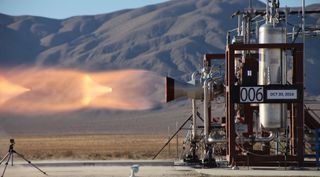Boeing's Starliner Launch Abort Engine Suffers Problem During Testing

WASHINGTON — Boeing confirmed July 21 that there was an "anomaly" during a recent test of the launch abort engines for its CST-100 Starliner commercial crew vehicle that could delay a key milestone needed for the vehicle to be able carry astronauts.
The incident happened during a hot-fire test of the engines used by Starliner's abort system, integrated into a spacecraft service module. The static test, which took place in June at NASA's White Sands Test Facility in New Mexico, was a prelude to a pad abort test of the system planned for later this summer.
"The engines successfully ignited and ran for the full duration," the company said in a statement. "During engine shutdown, an anomaly occurred that resulted in a propellant leak." [CST-100: Images of Boeing's Private Space Capsule]
Starliner uses a "pusher" escape system, with four launch abort engines mounted on the service module that can propel the spacecraft away from its Atlas 5 launch vehicle in the event of an emergency on the pad or during ascent. The engines, which use hypergolic propellants and generate 40,000 pounds-force of thrust each, are provided by Aerojet Rocketdyne.
Boeing didn't elaborate on the nature of the problem, but other sources, including social media postings several days before the official statement, claimed that a hydrazine valve in the propulsion system failed to close properly at the end of the test, causing the propellant to leak. Boeing didn't issue the statement until after the first published report about the anomaly by Ars Technica.
Aerojet, in an October 2016 release about an earlier set of hot-fire tests of the thruster, touted the use of "innovative" valves in the launch abort engines. Those valves, said company president and chief executive Eileen Drake, "demonstrate precise timing, peak thrust control and steady-state thrust necessary during a mission abort."
"We have been conducting a thorough investigation with assistance from our NASA and industry partners," Boeing added in the statement. "We are confident we found the cause and are moving forward with corrective action."
Get the Space.com Newsletter
Breaking space news, the latest updates on rocket launches, skywatching events and more!
It's unclear what effect this testing problem will have on the development schedule for Starliner, including the uncrewed and crewed orbital test flights of the spacecraft. Boeing said in its statement that it did not have any schedule updates for the test program, including for the pad abort test.
Updates on commercial crew test schedules for both Boeing and SpaceX are expected to be released as soon as next week. An Aug. 3 announcement, possibly featuring Vice President Mike Pence, had been planned for the Kennedy Space Center, timed to a previously scheduled Aug. 4 launch of NASA's Parker Solar Probe spacecraft. That announcement may go ahead even though the launch has been rescheduled for Aug. 6.
Even before this latest incident, the launch dates for both companies' uncrewed and crewed tests were widely expected to slip, perhaps well into 2019. A July 11 report from the U.S. Government Accountability Office cited internal NASA estimates that concluded that the companies would not likely win certification for transporting astronauts to and from the International Space Station until at least late 2019 or early 2020, and possibly not until late 2020.
The Aug. 3 announcement may include the assignment of NASA astronauts to the two companies' crewed test flights. Four NASA astronauts have been preparing for those flights since 2015, but for now have been training on both Starliner and SpaceX's Crew Dragon.
In an interview last September, Chris Ferguson, a former NASA astronaut who is now director of Starliner crew and mission systems at Boeing, said he expected those assignments to be made for the crewed Starliner test flight about a year before the actual flight.
This story was provided by SpaceNews, dedicated to covering all aspects of the space industry.
Join our Space Forums to keep talking space on the latest missions, night sky and more! And if you have a news tip, correction or comment, let us know at: community@space.com.

Jeff Foust is a Senior Staff Writer at SpaceNews, a space industry news magazine and website, where he writes about space policy, commercial spaceflight and other aerospace industry topics. Jeff has a Ph.D. in planetary sciences from the Massachusetts Institute of Technology and earned a bachelor's degree in geophysics and planetary science from the California Institute of Technology. You can see Jeff's latest projects by following him on Twitter.

